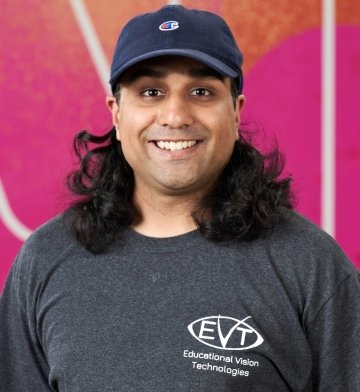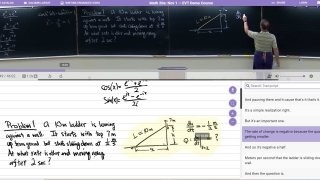When it comes to artificial intelligence, edtech companies have long known about and used AI to power and enhance their technology. As the integration of generative AI technology—AI that generates content rather than simply analyzing data and making predictions—becomes ubiquitous, companies worldwide are excited about the seemingly limitless prospects and applications of the technology in the education space.
USC Rossier’s EdTech Accelerator, managed by Associate Professor of Research Mark DeGennaro and Senior Fellow Doug Lynch, has been focused on accelerating the growth of early-stage companies developing technology solutions for K–12, higher education and workforce development for the past six years. “We started this program as a service to help early stage edtech entrepreneurs develop and implement efficacious products that increase access and improve learning outcomes for all learners,” Lynch said.
The Accelerator begins accepting applications each year in September and runs from October through April. At the end of the program, companies present to investors at the ASU-GSV Summit in San Diego.Those accepted to the program receive, among other things, operational, technical and business strategy assistance; product roadmap development; and access to stakeholders in the education sector, including educators, investors, foundations and service providers.
The Accelerator does not charge tuition, take equity or require founders to relocate, making the program accessible to all entrepreneurs irrespective of background or ability to pay. This commitment has paid off. Over 80% of the company founders who have participated in the program have been women or people of color, making the Accelerator the most diverse program of its kind nationally according to DeGennaro and Lynch. “Companies in the program have raised tens of millions of dollars, touched millions of learners and received numeous accolades and awards, making the Accelerator one of the most successful programs of its kind anywhere,” said DeGennaro.
Companies from all over the globe have participated in the program, and the most recent cohort included four companies based in Africa. “We are thrilled to see the impact our companies are having,” DeGennaro said “and, as we look forward, we see a tremendous opportunity to continue to expand our work beyond the U.S. markets.”
While many of the companies that go through EdTech Accelerator use AI in some fashion, several are using AI in truly groundbreaking ways. Among them are Avela, Sensay, Ingage, Breakthru, EVT and Megaminds. Read on to learn more about each of these companies and their CEOs.
Greg Bybee, CEO of Avela
Avela co-founder and CEO Greg Bybee considers himself a social entrepreneur and education technologist focused on equitable access to education. Avela is a modern enrollment system for early childhood, K–12 districts and charter schools, offering self-service tools to give families more agency in the application process.“Think of Avela like Open Table for education. It is a platform for families to navigate their child’s education journey and apply to K–12 schools and programs,” said Bybee.
Avela is a manifestation of Bybee’s passion for education. The Harvard and Standford graduate describes the platform as a one-stop shop where families can upload their child’s documents, from birth certificates to immunization records, and securely provide admissions information to schools, after-school programs and summer camps. Elements of AI are woven throughout Avela, particularly in the security and infrastructure layers of the platform, as AI and machine learning models have the ability to detect suspicious activity and block unauthorized logins.
One of the major efficiencies Avela provides schools is the centralization of the admissions process, which removes students from waitlists faster and ensures students get seats in classes and programs more quickly. Bybee estimates “we can speed up the time a family gets their child in a seat by three to four months, rather than having to see what transpires from a waitlist.”
Started in 2020 by Bybee and two professors from MIT, Parag Pathak and Josh Angrist, winner of the 2021 Nobel Prize in Economics, Avela is now in 18 states with over 2,000 schools and more than 1 million students on the platform. In the next two years, Bybee hopes to serve families in all 50 states.
Bybee describes Avela as “privilege-proof.” The platform does not take into account what connections a family might have at the school. Since the platform saves all a child’s information, it allows families to apply to more schools than they would otherwise have time to. Avela has a low barrier to entry; the platform is free for families to use and they have eliminated the need for an email address, a family can simply sign-up with a mobile number, which over 70% of families have done.
Bybee describes the Accelerator as a community unlike any other incubator, attracting a melting pot of experience levels. Besides staying well connected to his cohort and leaders of the Accelerator two years after graduation, Bybee said the Accelerator “focuses on the unique challenges that education entrepreneurs face, such as complex sales cycles, a highly regulated environment, and unique pilot and rollout policies.”
In addition to co-founding Avela, Bybee is the president and co-founder of PoliScribe, a platform used by members of Congress and state legislators to connect with their constituents and legislate more effectively. Bybee also sits on the Board of Trustees for Leadership High School and MathAction and is a member of the Board of Advisors for Rutgers University’s Center for Innovation Education.
Caren Chen, CEO of Sensay
Caren Chen, Sensay founder and CEO, was in a global rotation program for her job as a commercial leader at GSK when she found herself based out of three Asian countries at once. During this experience, the USC graduate noticed her colleagues struggling with the English language despite the large private industry for English instruction. Even though people spend vast amounts of time, money and effort to learn English, speaking the language is a struggle. After a year of discovery, visiting schools and interviewing educators, Chen determined that “the pain point was the lack of [an] immersive environment to learn English.”
Knowing that not everyone can afford a private tutor or attend an international school, Chen founded Sensay, a teacher tool that allows instructors to create speaking exercises for K–12 schools and university classes. Instructors create lessons using a variety of exercise formats that students read out loud or respond to verbally, and Sensay’s AI tool provides instant feedback on pronunciation, fluency and relevancy.

With the tap of a screen, students can continuously listen and practice by hearing different voices, which has been particularly helpful for students who are hard of hearing. For these students, Sensay provides an opportunity to hear instructions clearer since they are listening to the lessons through headphones. Not only has it helped with their comprehension of content, but it has also given some the confidence to participate in class discussions with their peers. Chen has heard stories from teachers who say they have heard a student’s voice for the first time after using Sensay.
Sensay incorporates AI throughout the user experience. Features such as text-to-speech for listening comprehension and speech-to-text for instant feedback on pronunciation and fluency is powered by AI. These features give the user scores on pronunciation and fluency, as well as an overall score. Behind the scenes, AI is used for intelligent infrastructure monitoring, spam detection and writing code for software development improvements.
While completing her BA and MBA at USC, Chen fondly recalls her time volunteering with the USC Joint Education Project, teaching in neighborhood schools. “Volunteering with JEP was my first exposure to vast disparities in education. That’s what made me passionate about education,” Chen said. Chen’s commitment to educational equity is one reason why Sensay has been successfully implemented in over 100 public schools and more than 30 private schools throughout Asia, North America and Latin America.
Jamal Madni, CEO of Ingage
Double Trojan Jamal Madni is an engineer by trade, but after a decade in the biotech and aerospace engineering sectors, he turned to education. Taking Doug Lynch’s inquiry course as a student in USC Rossier’s Doctor of Education in Organizational Change and Leadership program helped Madni reinforce his connection to educational innovation as he’s worked in the private sector. While working as a software engineer at Boeing, he also taught at Cal State Long Beach where he helped start the Upward Bound Program, a college preparatory program that helps encourage first-generation, low-income, underrepresented minority students to pursue a career in STEM.

“Education and technology have been inextricably linked throughout my life—my parents instilled a few fundamental life pillars, namely, the importance of lifelong learning and being technically fluent,” Madni said. When he embarked on his MBA at Stanford University and met Matt Davis in 2020, his dreams of combining these two passions began to take shape. The two were “deeply passionate about the intersection of technology and human connection,” Madni said. So often when it comes to technology, “much of society’s narrative is about technology replacing the human experience, or at best augmenting it, but we were fascinated by the idea of how technology can serve as a behavioral superpower for humans to become better versions of themselves. This notion of plugging ourselves into the machine to be better friends, children, parents, spouses and citizens—a true Internet of Us,” Madni said.
And then, the COVID-19 pandemic struck. As class president of the Stanford School of Business, Madni was tasked with helping “usher the school into the online era.” At the same time, Davis and Madni were researching ways to enhance the virtual meeting experience. And thus, Ingage was born. The two wanted to “unlock trust and engagement” in virtual settings in industries where these two phenomena are vital to generating outcomes, like education, health care and online sales.
Ingage “helps professionals read the virtual board room, exam room classroom through behavioral intelligence software” by providing users with feedback in real-time, post-virtual meetings, and longitudinally on the effectiveness of their online interactions. For example, when used during a virtual teaching session, an educator can be given feedback on how students engage during the class, at what points in the lesson they’re most engaged, when their comprehension peaks and troughs as well as how well they’re responding to their teacher’s pedagogical style. Ingage can tell teachers that students are having trouble following a lesson which might prompt the teacher to slow down and allow time for questions. After the lesson concludes, teachers are given a summary of their performance. And after a teacher uses the software for some time, it can make recommendations on things like “what is the best strategy for a fourth-grade educator teaching a foreign language in the United States versus an eleventh-grade educator teaching calculus in Europe,” Madni said.
The software can do this by using real-time AI-powered algorithms that monitor things like facial expressions, tonal analyses, conversational themes, real-time interruptions and talk ratios. “We went into the literature very extensively to see what universal behavioral cues exist to indicate certain things,” Madni explained. For example, “regardless of country or culture, or type of industry or classroom, two of the universal proxies that exist for approval are nodding and smiling,” Madni said. When a person smiles, it brings blood to the surface of the skin in their face, affecting the pixelation of the face. Ingage can measure these subtle changes to gauge real-time student engagement.
While Ingage was initially created for the education industry, Davis and Madni quickly realized how many other industries could benefit from its use. In 2023, VidCruiter, one of the largest video interviewing platforms in the world, acquired Ingage, to intelligently minimize unconscious bias and scale equitably effective hiring outcomes worldwide. As Madni shared, “so many think that edtech is a siloed market floating on an island, but education was truly the gateway to Ingage’s holistic impact journey.”
Melissa Painter, CEO of Breakthru
Melissa Painter, founder and CEO of Breakthru, has been disrupting the well-being movement for the past seven years. She is rethinking the relationship that students and employees have with movement throughout the day, citing the mental and physical health consequences and cognitive impact of sitting for long periods. “Breakthru came to be as we were thinking about how to get people to take short moments of motion throughout the day,” said Painter. The company uses emergent technology, from augmented and virtual reality to body sensors and machine vision, to get people moving.
When a user opens the Breakthru app, they choose an emotion that they would like to feel. Breakthru’s large movement body leads the user through a sequence of motions based on the desired feeling, such as joyful, energized or confident. Generative AI and machine vision are used to track the user’s body through the camera on your device, which allows the program to change the visual and audio. “The app is very alive and provides a sticky experience for the user with immersive nature scapes and soundscapes that change with the user’s body movement for them to work on breathing and balance,” Painter explained.
Today, Breakthru is used in over 45,000 organizations and schools in more than 72 countries, predominantly through the Microsoft ecosystem, but also on Google, Slack and Zoom. Approximately 20% of users are from traditional schools, from preschools in Poland to USC. Teachers often use the program to get their students up and moving throughout the day, but “it can also be used by adults in the workplace as an educational tool to help them learn how to use their body to activate their mind,” Painter said.
Painter received her BA from Columbia University and her Master of Fine Arts from the NYU Tish School of the Arts. An innovative strategist, writer and award-winning filmmaker, her diverse background focuses on the intersections of emergent technologies and human intent and on employing design to tackle the challenges of today and the future.
As a mission-driven entrepreneur, Painter appreciated being around like-minded founders in the Accelerator. Years after graduating from the program, Painter remembers “one of my favorite things about being part of the Accelerator was to hear what kinds of problems other companies were tackling and why; this gave me a great appreciation that I was not alone in my journey.”
Monal Parmar, CEO of EVT
For Monal Parmar, CEO of Educational Vision Technologies, making learning more accessible and engaging is personal. In fact, the first iteration of EVT was born out of Parmar’s need for a better way to take notes during his robust and difficult load of STEM classes while studying for his bachelor's in electrical and computer engineering at UC San Diego. “I myself have a disability, and it was very difficult for me to take notes and understand the material at the same time. So that’s the genesis of where EVT came from,” Parmar said.
One of the challenges Parmar faced was that, in his STEM classes, there was often intense use of either chalkboards or whiteboards to explain equations, and it was difficult for him to take notes while also following the professor’s lecture. As Parmar was studying machine learning, “he started developing an automated note-taking system that creates notes from standard whiteboards and chalkboards.” EVT expands on this, and in its current form, the platform can “extract, enhance, and organize board writing from uploaded lecture video recordings to create interactive lecture notes,” according to the company’s website.

EVT curates board-based lectures into interactive notes and also generates what Parmar calls a “video pdf.” The video pdfs include a table of contents, bite-sized video clips of the lecture, the equations that were written on lecture boards during the lecture and detailed notes. The graphics of the equation and notes are also interactive. Users can simply click on a part of the equation or the notes and be taken to the moment in the video where the professor was discussing that particular point.
The creation of these video PDFs depends on the modality of the class. If it’s an in-person lecture, the lecture will be recorded, and then EVT’s patented, AI-powered platform is fed this video and gets to work. It will analyze the video and “detect the professor, the equations, graphs and diagrams and extract all of the writing. It then groups the writing with the [corresponding] equation or graph. It organizes everything just like a student notetaker,” Parmer said.
There is also a human in the loop who reviews the AI-generated content, Parmar explained. “We have a two-step process. AI, plus human, because when it comes to learning material, you need everything to be accurate,” he said.
Schools like UC San Diego, receive note-taking requests from their disability office, but fulfilling these requests proves challenging. Many schools rely on student volunteers to take notes, Parmar explained, but with the introduction of EVT, schools are better equipped to meet the needs of their students with disabilities. EVT works extensively with UC San Diego, where their product is used in over 100 courses. The company also has contracts with the University of Arizona and the University of San Diego. Several schools are also starting pilot programs with EVT, including UCLA.
One of the major challenges EVT faced when it broke into the edtech industry was the hesitance to change the “status quo” in higher education institutions, Parmar explained. Universities can be resistant and slow to change and also have difficulty allocating resources for new tools like EVT, Parmar said. But he’s hopeful. A recent university client was able to contract with EVT in just three weeks, “from initial meeting to approval.”
Parmar is also hopeful about AI and education in general. “AI can augment lectures [creating] more interest and engagement from the learner. The end goal is to see more people go to college, finish college and get their degree to have more career opportunities.”
Eric Tao, CEO of MegaMinds
“Think Roblox, but for learning,” Eric Tao said when describing MegaMinds, the immersive learning platform he founded in 2022. Originally created as an immersive learning system to be used in a pilot program as a part of the New York City Department of Education’s Imagine Schools Initiative, Tao and his team shifted their focus after the project was put on hold during the COVID-19 pandemic. Instead of developing a system for a single school, they decided to think bigger and make it a software platform available to all learners.
The genesis for Megaminds came about when Tao, a Google alum, was working on some of the company’s first immersive experiences. “That was where I first realized the power and impact they could have,” Tao said, “particularly with digital natives, and especially in education.”
This spark led him to think about “packaging high quality, immersive learning and making it accessible on every device in the world.” Tao wanted to impact “almost any student, irrespective of socio-economic background or geographical location.” It’s this idea that has become the “north star” for Megaminds.

MegaMinds uses immersive technologies like WebXR combined with AI and “virtual game mechanics to increase student engagement and personalize learning at scale.” For example, teachers can provide students with a virtual world that acts as a blank canvas for project-based learning activities. Students can demonstrate their understanding of a particular lesson by constructing 3D worlds and making individual choices that tailor the learning experience to their needs. This approach allows a personalized educational experience for students, giving students ownership of the project, Tao explained..
As the company grows, Tao and his team are excited to continue to integrate AI into the platform. In fact, one of MegaMinds’s founding engineers just received his PhD in artificial intelligence, and the company is planning to integrate AI into the “generation of lesson content, both 3D and 2D,” Tao said. They are also considering “embodied AI coaches and tutors that are sort of like non-playing characters in a video game,” he said. While MegaMinds is focused on providing personalized learning to students, the company also aims to be a useful tool for teachers. They hope to enhance and personalize their insight data for teachers with the help of AI.
A major challenge Tao sees when it comes to integrating AI into products serving the education industry is shifting the “mindset that AI should make everything faster.” Rather than focusing on how AI could help teachers respond to emails and write individualized educational programs more quickly, Tao believes AI has the capacity “to give teachers superpowers, to improve their pedagogy and make them better teachers.”
Tao is most excited about AI’s “potential to personalize learning for every student in the world, no matter their age.” He believes that “we’re still very early” when it comes to integrating AI and education. “The real game-changing stuff … that is still to come,” Tao said.





